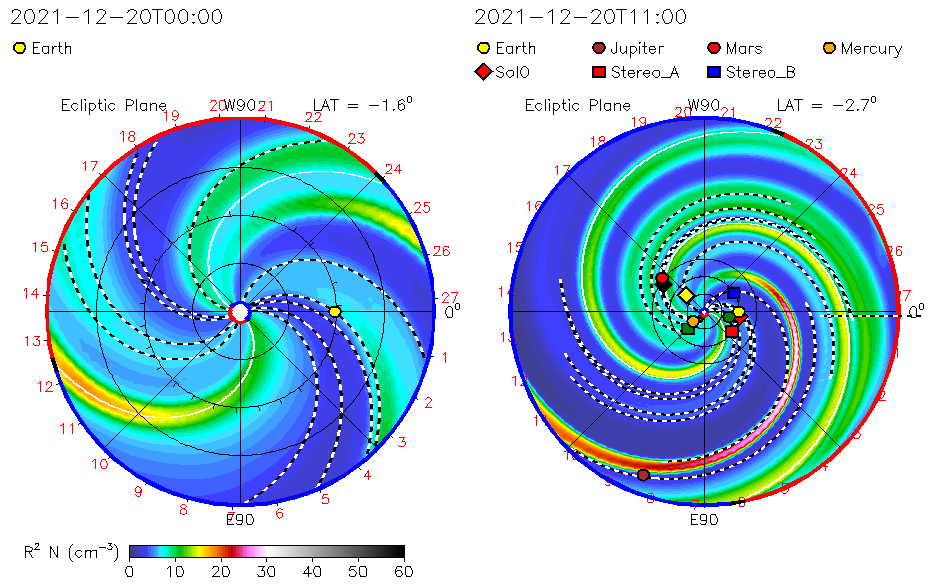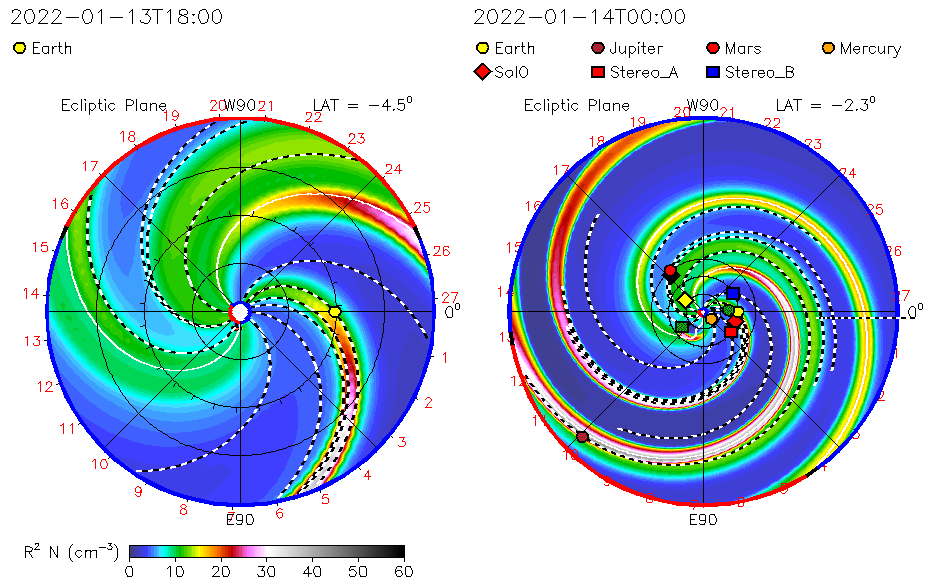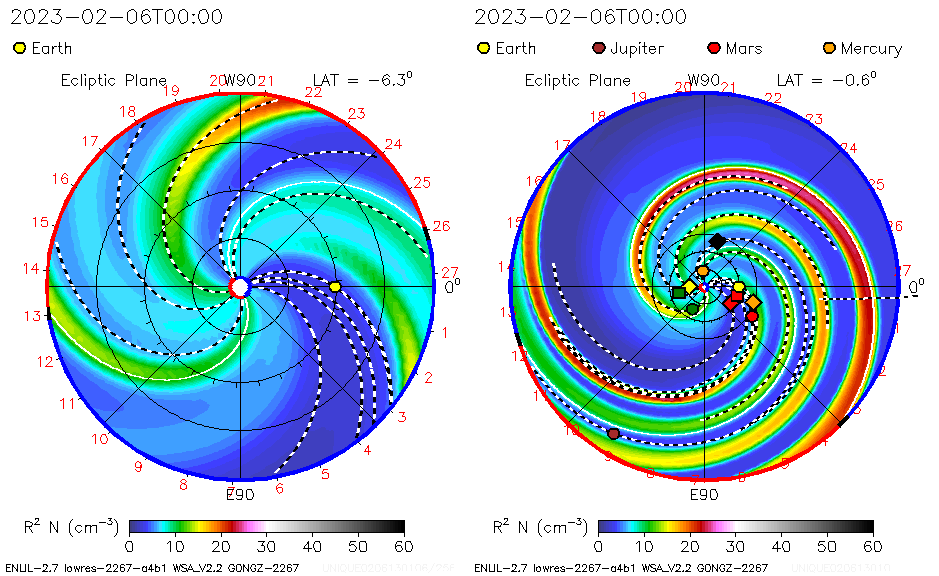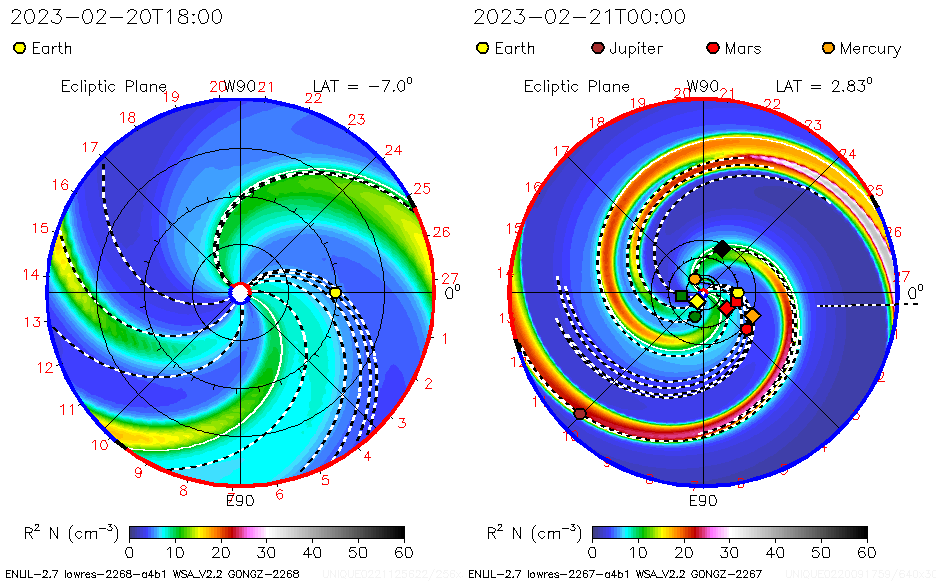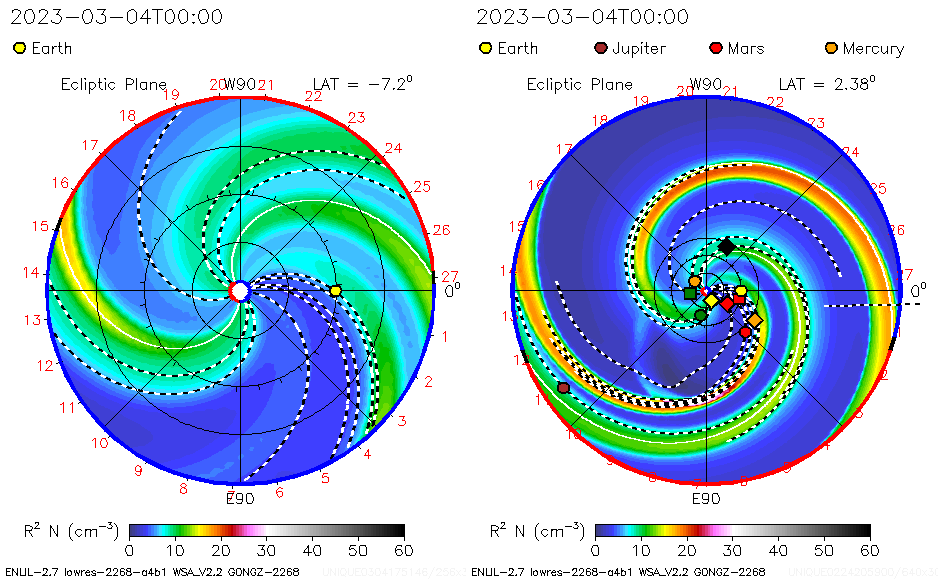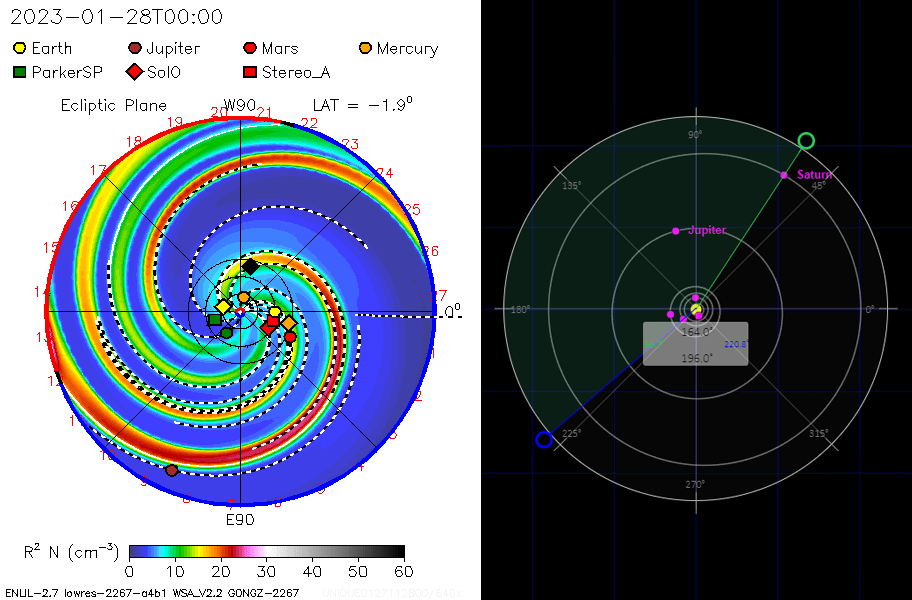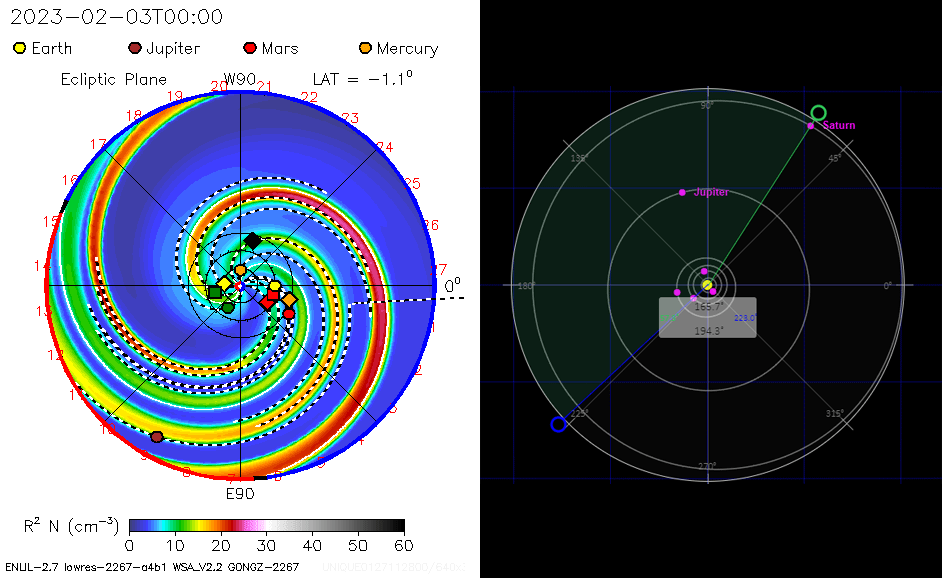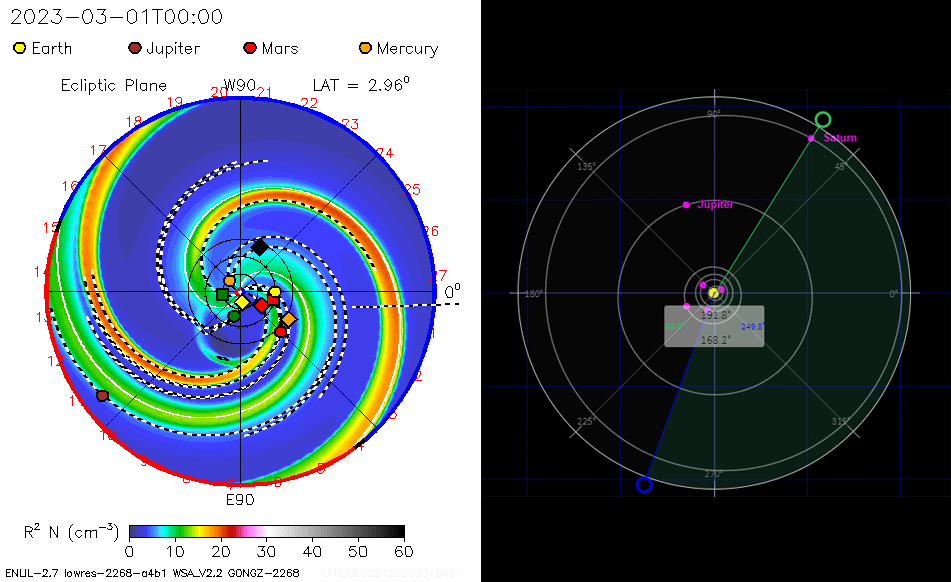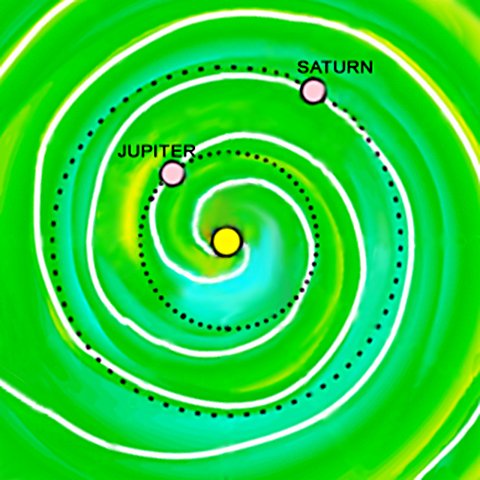In my research of history, I have discovered that there have been cataclysms in the past so massive that they could not have been caused by terrestrial forces alone. Wanting to explain their cause, I became interested in the cosmos and discovered that the greatest cataclysms on Earth are caused by the magnetic influence of the planets. This discovery enables us to predict the date of earthquakes based on space weather. I'm new to astrophysics, so I'm ready to take all your remarks into consideration.
Introduction
This animation created by NASA shows the forecast of space weather in the solar system. At the top you can see the date and time of the forecast. Let's focus on the image on the left. The white dot in the middle is the Sun, and the yellow dot on the right is Earth.
Sunspots give off the solar wind, a stream of plasma composed primarily of protons, electrons and alpha particles. Areas of dense solar wind are marked in green-yellow-orange. The stream of plasma flies from the Sun straight into space. As the sun rotates all the time, so does the direction of the solar wind. For this reason, the plasma stream takes the shape of a spiral. The solar wind may appear to revolve around the sun, but this is only an illusion. In fact, the solar wind moves in a straight line from the sun. This is clearly visible in the example of a solar flare that emanates from the Sun and travels in the upper-right direction.
The solar wind carries the Sun's magnetic field far into space. The sun's magnetic field thus assumes a spiral shape. The white lines extending from the Sun in the region of the dense solar wind are the heliospheric current sheet. This layer separates the two regions of the sun's magnetic field in opposite directions. On one half, the direction of the magnetic field is directed towards the Sun, and on the other - away from the Sun. The outer edge of the circle is colored red and blue, representing two regions of the magnetic field with different directions. Due to the magnetic forces involved, there are usually two dense plasma streams at the boundary between the sectors, which are directed in opposite directions.
Around the circle we see numbers from 1 to 27, which are the measure of days. Every day, the current sheet rotates by 1 point, which is caused by the rotation of the Sun around its axis. It takes 25.38 days for the Sun to make one complete rotation.(Ref.) However, during this time the Earth travels some distance in its orbit, so the current sheet takes another almost two days to catch up Earth. Therefore, it takes an average of 27.28 days for the current sheet to rotate relative to the Earth. This is a theoretical value, and in practice the position of the current sheet depends on the space weather, so the rotation time is variable.
The planets Jupiter and Saturn have a longer orbital period around the Sun, so they cover a smaller angle of their orbit in one rotation of the Sun. Because of this, the sun's magnetic field takes less time to make a full rotation relative to these planets. It takes an average of 25.44 days for the solar magnetic field to rotate relative to Saturn and 25.53 days relative to Jupiter. During this time, the heliospheric current sheet and dense solar wind streaks pass through each of these large planets twice. I believe that each such passage causes a disturbance of the magnetic field in the plasma stream, which creates the risk of cataclysms on Earth.
According to the laws of physics, when a magnet moves near a current conductor, it creates an electric current flow in it. In turn, the flow of electric current in a conductor creates a magnetic field around it. Jupiter and Saturn have a very strong magnetic field, that is, they are magnets, and magnets of enormous size. In turn, the solar wind and the current sheet running in it are good conductors of electricity. I believe that when the magnetosphere of large planets comes into contact with a dense stream of plasma, then a strong electric current is created in it. This electric current flows over the plasma stream and creates a strong magnetic field around it. My guess is that this magnetic field can affect the Sun, causing solar flares. It also affects the Earth, causing strong earthquakes and volcanic eruptions. Jupiter and Saturn pass through a dense plasma stream once every less than 2 weeks, which is why I called this cycle the 2-week cataclysm cycle. Although, in fact, the timing of the planets' passage through the plasma stream depends on the state of space weather, so cataclysms do not happen on a regular basis. The 2-week cycle is just a convenient name.
Space weather forecasts can be found on NASA's website:
WSA-Enlil 5.5 AU +CME Animation
Enlil 5.5 AU no-CME Image
WSA-Enlil 2 AU +CME Animation
Hunga-Tonga volcano eruption
Let's check whether large cataclysms are really caused by the interplanetary magnetic field. Let's look at the 2022 Hunga-Tonga eruption. The eruption was rated at VEI-5 or 6. It was the largest volcanic eruption since the 1991 eruption of Mount Pinatubo, and the most powerful eruption since the 1883 eruption of Krakatoa. Scientists cannot explain why this outburst was so extraordinarily powerful.
The record-breaking eruption occurred after an approximately month-long period of eruptive activity. The first phase of Hunga-Tonga eruption began on 19 Dec 2021 at 20:40 UTC,(Ref.) shortly after which the altitude of an umbrella cloud reached 15 km. Let's see what space weather was like at the time of this eruption. The image on the left shows space weather near Earth, 3 hours and 20 minutes after the eruption. The image on the right shows the state within 5.5 AU (or Jupiter's orbit), 14 hours and 20 minutes after the eruption. The brown dot at the bottom of the circle is Jupiter.
We see that at the time of the December eruption, the Earth was at the edge of a medium-density plasma flux. Jupiter was also not far in front of the dense plasma stream. These space weather forecasts are not super accurate and may be slightly different from the actual situation. It is likely that the eruption occurred just as Jupiter was entering the plasma stream. So it is likely that it was Jupiter's interaction with the plasma stream that caused the disturbance of the interplanetary magnetic field, which resulted in a volcanic eruption on Earth.
In the following days, the Hunga-Tonga volcano experienced several smaller eruptions. As activity on the island decreased, it was declared dormant on 11 January 2022. The volcano resumed its activity around 25-26 days after the first eruption. This period just coincides with the duration of one complete rotation of the solar magnetic field. A large eruption commenced on 13 January 2022 at 15:20 UTC, sending clouds of ash 20 km into the atmosphere. A day and a half later, on 15 January 2022 at 04:15 UTC,(Ref.) the shallow water Hunga-Tonga volcano produced the past century's most energetic eruption. The eruption column rose 58 km into the mesosphere. Let's see what space weather was like at the time of these two eruptions.
The situation in the pictures looks very interesting! At the time of the first eruption, both Earth and Jupiter were just entering a very dense stream of plasma. However, at the moment of the record-breaking second eruption, both planets were just coming out of the stream! A situation in which both planets align simultaneously on streams of very dense plasma is probably extremely rare. In this case, it coincided with a record-breaking volcanic eruption. I think this remarkable coincidence confirms that the cause of the eruption of the Hunga-Tonga volcano was the influence of the solar plasma magnetic field on the Earth. This supports the theory that the magnetic interaction of planets can trigger cataclysms on Earth.
Recent cataclysms
Let's look at the cataclysms that happened in the recent weeks and see if they were caused by forces from outer space. I selected several natural disasters from February 1 to March 17, 2023. The list included earthquakes with a magnitude of 6.9 or greater and those that killed at least 10 people, and X-class solar flares.
Feb 6 (1:17 and 10:24) - M7.8 and M7.5 Earthquakes (Turkey)
Feb 11 (15:40) - X1.1 Solar flare
Feb 17 (19:38) - X2.2 Solar flare
Feb 20 (17:04) - M6.3 Earthquake (Turkey)
Mar 3 (17:42) - X2.1 Solar flare
Mar 4 (6:41) - M6.9 Earthquake (Kermadec Islands)
Mar 16 (0:56) - M7.0 Earthquake (Kermadec Islands)
You can find a list of the largest earthquakes and solar flares here:
Earthquakes by magnitude
Earthquakes by death toll
Top 50 solar flares
Earthquakes of February 6
A devastating earthquake happened on February 6, 2023 in Turkey and Syria. At 1:17 a.m., the first magnitude 7.8 quake occurred. Then, at 10:24 AM, there was a 7.5 magnitude aftershock. During this quake, the tectonic plate shifted 8 meters. The earthquake killed 58,000 people, making it the 10th deadliest earthquake in the last 100 years. Let's look at what space weather was like at the time of this cataclysm.
In the image on the right, we can see that at the time of this earthquake, Jupiter was only hours away from entering the plasma stream and crossing the current sheet. This space weather forecast was released a week earlier, so it may be a little inaccurate. It is likely that Jupiter was crossing the current sheet at the time of the quake, and this event was the cause of the cataclysm. The image on the left shows that at the time of the quake, Earth was in an area of rare plasma concentration. This shows that Earth does not necessarily have to be in a region of dense plasma to experience the effects of an interplanetary magnetic field. Although, as the example of the Hunga-Tonga eruption shows, when the Earth is in an area of dense plasma, then the cataclysms are stronger.
Earthquake of February 20
Another significant earthquake in Turkey occurred on February 20 at 17:04. It had a magnitude of 6.3, so it wasn't particularly strong, but it caused 13 fatalities. Here's what the cosmos looked like at the time of the quake.
We see that at the time of the quake, the Earth was in the region of the rare solar wind. Jupiter, on the other hand, was just entering a dense stream of plasma and crossing the current sheet. This is another cataclysm that coincides with Jupiter's entry into the plasma stream.
Solar flare on March 3rd and earthquake on March 4th
On March 3 at 17:42 there was a solar flare with a magnitude of X2.1. It was the second strongest solar outburst since the beginning of the 52-year cycle. Shortly afterwards, on March 4 at 6:41 AM, there was a 6.9 magnitude earthquake in the Pacific Ocean (the strongest quake in 26 days). Let's look at what space weather was like at that time.
We see that at the time of these cataclysms, the Earth was at the limit of the medium-density plasma flux. Jupiter was also on the edge of the plasma flux, and in addition was close to the current sheet, which could have disturbed the interplanetary magnetic field and initiated cataclysms. This gives us another confirmation of the theory about the influence of planets on the formation of cataclysms.
February 11 solar flare
On February 11, at 3:40 p.m., a solar flare of magnitude X1.1 occurred. It was the third strongest flare since early February. It occurred shortly after Jupiter emerged from a dense plasma stream. However, this planet was probably already out of the stream, so its influence should not have contributed to the flare. So we will check whether the flare could have been caused by the magnetic influence of another large planet - Saturn.
Unfortunately, I couldn't find a forecast of space weather near Saturn on the NASA website, so we have to calculate this based on the space weather at Jupiter's orbit. To determine what the space weather was like in the vicinity of Saturn at the time of the flare, we need to check what the space weather looked like in the orbit of Jupiter several days before the flare.
The image on the left shows space weather to the distance of Jupiter's orbit on January 28, 2023 at 0:00 (so less than 15 days before the solar flare). The planet Saturn is not visible in this picture because it lies far beyond Jupiter's orbit. To estimate where Saturn should be in this drawing, we need to look at the alignment of the planets that day. The image on the right shows what position Saturn was in relation to Earth at that time. I took the alignment of the planets from in-the-sky.org, and to measure the angle between the planets I used a Chrome extension called Protractor. The protractor shows us what position Saturn was in relation to the Earth (the 3rd planet from the Sun is Earth). We can see that on 28 January, Saturn was at an angle of 164° to the Earth. Now let's look at the image on the left to find where Saturn should be. If Saturn were plotted in the image on the left, it would be well outside the circle, in a direction that makes an angle of 164° to the Earth (yellow dot). Thus, Saturn should be approximately in the direction marked "12" on the circle, perhaps slightly above it.
We can see that on the border of the circle near the number "12" a dense stream of plasma was passing along with the current sheet. I think that if we pushed this forecast back in time by several hours, then the current sheet would be headed exactly towards Saturn. This stream of solar wind moves in a straight line from the Sun towards Saturn. The solar wind travels at about 500 km/s, so it will take about 15 days to travel from 5.5 AU to Saturn (~9.8 AU). From his observations, he concludes that a value of about 14 days 20 hours works best. This is not an exact value, because the exact speed of the solar wind is difficult to determine. The plasma, which was located at the number "12" on the circle on January 28, was heading directly towards Saturn and should reach it in the second half of February 11. It was on that day that Saturn crossed the current sheet and entered a dense stream of plasma. It just so happens that at that time there was a strong flare on the Sun. The flare occurred at most a few hours after Saturn crossed the current sheet, or perhaps at that very moment. Thus, it appears that Saturn's interaction with the plasma stream was most likely the cause of this strong solar flare.
February 17 solar flare
On February 17, at 19:38, there was a very strong solar flare with a magnitude of X2.2 (the strongest since the beginning of the year). It was not due to the influence of Jupiter. We'll check if it was caused by the influence of Saturn. Let's do the same analysis as above. Let's start by checking what the space weather was like around Jupiter's orbit around 15 days before the outburst, and find out where Saturn was at that time.
We see that on February 3, Saturn was at 165° to the Earth. If we marked Saturn in the picture on the left, it would be outside the circle, in the direction lying between the numbers "12" and "13". We can see that there was a dense stream of plasma in that place. This stream extended from the direction marked with the number "11" to the direction marked with the number "14", meaning it had a width of 3 days. The plasma from this stream was headed straight for Saturn and should have reached it in about 15 days. So the stream should pass through Saturn from February 16 to 19. A powerful solar flare occurred around the middle of this period. So we see that in this case the influence of Saturn could again be the cause of the flare.
Earthquake of March 16
On March 16 at 0:56 a.m. there was a strong earthquake under the Pacific, in the area of Kermadec Islands, which had a magnitude of 7.0. Let's see if this quake was caused by the influence of Saturn. Let's see what the space weather was like 15 days earlier, on March 1.
We see that Saturn was at 168° to Earth that day. If we transfer this angle to the image on the left, it will indicate the position of Saturn between the numbers "14" and "15", so very close to the current sheet. After about half of the day, i.e. on March 1 at 12:00, the current sheet should be exactly between the numbers "14" and "15". Add 14 days and 20 hours to this date, and it turns out that on March 16, around 8:00 am, the current sheet should reach Saturn. The earthquake blew 7 hours earlier. Even if Saturn did not cross the current sheet at the time of the earthquake, it was in a dense plasma stream and could have a magnetic effect on space and Earth. At the time of this event, Earth was in the region of the rare solar wind.(Ref.) Despite this, Saturn's influence proved to be sufficient to cause a strong earthquake.
Great cataclysms
The above analysis proves that the magnetic interaction of Jupiter and Saturn can indeed cause cataclysms on Earth and explosions on the Sun. I think the impact of the planet is when it enters or exits a dense plasma stream, because then the force of its attraction suddenly increases or decreases. The mere presence of a planet in a stream does not have such clear effects. However, the greatest impact occurs when the planet passes through the current sheet, because then it enters the area with the opposite direction of the magnetic field. Its force suddenly reverses then, eg attraction turns into repulsion. In this case, the change in the force of interaction is therefore double.
The biggest recent cataclysms were the earthquake in Turkey, which was caused by the influence of Jupiter, and the eruption of the Shiveluch volcano on April 10, 2023 with the strength of VEI-4, which was caused by the influence of Saturn. However, these were not the great cataclysms that we know from past global cataclysms. Medieval chroniclers wrote about powerful earthquakes, which were accompanied by such large shifts of tectonic plates that "a village had moved a distance of four miles". You can read about historical global cataclysms at Reset676.com. I think there's an explanation why some cataclysms are so powerful. The cataclysms of recent weeks were caused by the influence of only one of the planets. However, the really big cataclysms happen when both planets affect the Earth at the same time. The image below will help you understand why the impact of both planets can sometimes occur at the same time.
To create this image, I used the actual shape of the current sheet, which I found in NASA materials and which occurred on February 8, 2015.(Ref.) However, I have rearranged the planets in such a way that they are aligned as they were during the past global cataclysms. A similar alignment of the planets will occur in 2023-2025. This picture is to help you imagine the mechanism of the formation of cataclysms. In reality, the shape of the current sheet is variable and may differ from the one shown in the picture. Typically, however, there are two current sheet lines spiraling away from the Sun, each in the opposite direction.
We see that when Jupiter and Saturn are at about 70° to each other, then both current sheet lines pass through Jupiter and Saturn at the same time. Thus, both planets simultaneously affect the interplanetary magnetic field and cause cataclysms with double power. This may explain the mechanism of great cataclysms that have occurred in history.
I suppose that great cataclysms can be created by feedback. The passage of the planets through the plasma stream disturbs the Sun's magnetic field, causing strong solar flares. These solar flares give off large amounts of plasma, making the plasma streams denser and more conductive. The next time the planet passes through the stream, then its influence will be even stronger than before. This will cause even more powerful solar flares, which will give off even more plasma and increase the impact of planets and the power of cataclysms. The mechanism winds itself up, eventually leading to ever-larger, tremendous earthquakes.
The discovery of the influence of interplanetary magnetic field on cataclysms allows us to predict earthquakes and solar flares based on space weather. I post my cataclysm predictions on my forum and on my twitter. So far, I have made 3 predictions, 3 of which have been successful. This finally confirms that my theory is correct.
I base my predictions on space weather forecasts from the NASA website: WSA-Enlil Cone 5.5. Unfortunately, NASA provides this type of data irregularly and rarely. For more than a month, no new forecasts have been published on this website, and this makes it very difficult to predict cataclysms. I need information on space weather for the next few days, including CME, to the distance of 5.5 AU or more. If you know where I can get such predictions, please let me know, it's very important. Author: Marek Czapiewski




